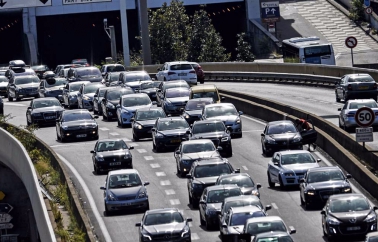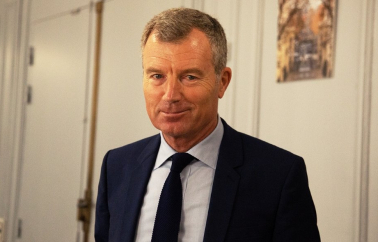
Transport in Europe: investment, competitiveness and ecological transition (Source Fondation Robert Schuman)
Transport in Europe: investment, competitiveness and ecological transition
18/01/2016
Abstract :
Transport is more than just a question of mobility: it is a factor of competitiveness. Without transport, there is no trade, no movement of goods or people, no Single Market and even less the European Union. From the beginning the European project has endeavoured to create a "European area of transport" even though reticence on the part of the Member States has often impeded this ambition. At present the revival of the European economy is dependent on a revised, renewed "European transport policy". Although the European Commission has just announced the financing of over 250 projects for a total of 13.1 billion €, as part of the European Interconnection Mechanism (EIM) we might question the choice of investments in terms of environmentally friendly, competitive modes of transport.
I - Transport, a factor of competitiveness for Europe
I.1. The management of the logistics chain is the focus of business strategy
Today logistics cannot be reduced to a simple support function the cost of which simply needs to be reduced. On the contrary it must form the heart of a company's strategy. The increasing differentiation of products means the development of logistics solutions to take the product to the end consumer in the shortest possible time which in turn demands a dense, meshed network and reliable, quality services.
The globalisation of production has shattered the value chain between several countries even continents, and it is vital to keep this in view. The continuous adaptation of these production chains demands a great deal of flexibility in terms of modes of transport. Hence the trading of raw materials relies on the ability to manage the logistics between the various manufacturing sites according to fluctuating prices; this explains why traders increasingly invest in transport and storage infrastructures so that they can adapt their logistics strategies in real time.
I.2. The dynamic of the Single Market depends on dense, reliable, quality transport networks.
The quest for increasing yields through agglomeration leads to a geographical concentration of manufacturing and innovative activities like the international cities of Paris and London, the Rhine delta (Benelux) and the Pô Valley. The concentration of investments and the search for synergy helps towards gains in productivity. Since the industrialisation of knowledge needs proximity, mobility within these territories is obviously vital and it is hardly surprising that their transport networks are amongst the densest in the world.
Productive centres responding to a logic of territorial specialisation need to be linked together by motorways, air links, railways, canals and pipelines. This is the function of the Brenner Tunnel for example linking to the two highly productive regions of Bavaria and Venetia. Conversely it would be wrong to believe that the liaison between two regions precedes their specialisation. Hence far from being a lever of growth the arrival of the TGV in a small town more often than not brings it within the sphere of influence of the grand metropole to which it is then linked. Major transport infrastructures do not structure a territory as much as they polarise them extending the spheres of influence of the most productive centres.
Finally in order to take full advantage of the European market businesses need access to all consumers. Transport systems should link the most distant valleys and the most isolated islands. It is important for fresh products to be delivered on time, that the customised T-shirt bears the right name, that even someone living in the north of Sweden can import Portuguese wine if he so desires it.
The Common Market needs competitive transport systems to structure the value chain, foster innovation and support consumption, i.e. dense, diversified, good quality infrastructures and reliable, cheap, flexible services. The development of the Single Market is therefore intrinsically linked to that of "Transport Europe".
II. Transport Europe is moving forward too slowly
II.1. The States are still attached to their prerogatives and relinquish them grudgingly
In spite of this requirement on the part of Europe the continent is still a mosaic of national transport systems which struggle to overcome their differences, unlike the USA where transport now seems to be continent scale. The Member States are aware of what is at stake but they only relinquish their prerogatives after hard fought community battles. Hence the ambition to have a "common transport policy" to guarantee the "free movement of goods, people, services and capital" in support of the Single Market under the Rome Treaty has come to nought since the States have subject it to the unanimity principle to prevent these measures having "a serious effect on the standard of living and on employment in certain areas and on the operation of transport facilities [1]"which in practice hindered all progress until the 1980's.
Transport has remained a subject that excites passions. For a long time often nationalised transport systems, were used to conquer national space (the Zollverein road network in Germany in the 1830's, the Freycinet river network in France at the end of the 19th century etc.) and have remained closely linked to the public realm which has made their Europeanisation extremely difficult. The European Court of Justice's decision of 22nd May 1985 decided that "the international transport of freight and passengers must be open to all businesses in the Community and must not be the focus of discrimination due to nationality or place of establishment of the transporter," and this was the sign for the true launch of the European transport policy which was confirmed by the Single Act of 1986. The qualified majority substituted unanimity, thereby opening the way to greater European integration in view of the creation of the Single Market - which was then confirmed by the Maastricht Treaty.
II.2. Transport Europe was first built on its roads
Europe, which is caught between national attachment to transport and border breaking globalisation, has found legitimacy as it has conceived a "European transport area": this has meant the development of trans-European infrastructures within continental corridors, the drafting of safety and interoperability standards, the liberalisation of services to create a common market. But these vital investments - whether it involves the adoption of the same European road traffic monitoring systems (ERTMS) or joint air traffic control rules (Single Sky) are of size and take time.
Road transport was both the first liberalised mode of transport in the 1980's and has been the greatest success in terms of European policy. But whilst other countries liberalised all of their transport systems simultaneously [2], Europe opened its systems up progressively. The lag factor gave road transport a cutting competitive edge since it had time to adapt to the new rules and become more competitive than its future rivals. Road hauliers anticipated the opening perfectly by drastically reducing their costs (30% to 40% according to estimates [3]) and by diversifying their services. The consolidation of the sector around major players did not prevent the emergence of smaller logisticians, thereby creating a self-managing dynamic. Advantageous pricing can be added to this initial edge enjoyed by the road sector: greater safety requirements on the railways raises fixed costs but since the road sector does not internalise any negative effects (noise, pollution) the cost to the user is artificially reduced [4]. Everything worked to make road transport dominant in Europe in just a few decades. It increased by more than 315% between 1970 and 2010, whilst other modes of transport stagnated (+27% river transport, -4% railway and -10% oil pipelines). The share of the road sector in land transport rose from 40% in 1970 to over 70% at present i.e. nearly double. Railway freight transport has collapsed, dropping from 30% of the traffic in 1970 to 15% in 2015.
Source: OECD and the author's calculations
III. Road transport also has to undergo a green revolution
III.1. The EU has banked on "ecological" modes of transport (rail and river) against road
But although road transport matches requirements in terms of flexibility and the capillarity of businesses it has significant environmental impact. As it became aware of the impact of congestion, threats to safety and the effects that the sharp development of road transport was having on the environment, the European Union adopted a "modal shift" principle in its White Paper on the future development of the common transport policy adopted in December 1992, ie the transfer of road traffic towards less pollutant means of transport such as rail and river. The 2001 White Paper "European Transport Policy by 2010: a time for choice" sets out this goal proposing the creation of the "motorways of the sea", fostering interoperability via the "Marco Polo" Programme and the co-financing of non-road and cross-border infrastructures (Lyon-Turin, the Pyrenees crossing). Remorseful, it seems that the European Union has focused its action on promoting alternative modes of transport via the unification of the European area (interoperability, harmonisation of working conditions), the development of infrastructures (trans-European network) and the promotion of quality transport systems (strict safety requirements, liberalisation of transport services to enhance productivity), and via the neglect and even "demonization" of road transport.
III.2. Road transport needs an "energy transition"
This negative vision of road transport, a legacy of the 20th century, should however be differentiated. R&D to improve environmental efficacy of road vehicles has been considerable. In ten years the average CO2 emissions of private cars have reduced from 150g/km to 110g/km, i.e. -25% [5] and European standards on pollutant HGV emissions helped reduce CO2 emissions by 40% and by 60% in terms of hydrocarbons between 1990 and 2007 [6]. The stabilisation of CO2 emissions in Europe would imply a 60% reduction at least in the consumption of diesel and petrol [7]. Therefore dissociating the expected rise in road traffic from the reduction or stabilisation of pollutant emissions supposes support to R&D and an increase in the price of the barrel of oil taxes.
Practices can evolve as seen in the success of car-pooling [8]. Logistics might also move towards practices like this. The development of electric utility vehicles and semi-automatic driving, as well as geolocation solutions, could help towards an "energy transition in road transport." For regional travellers the "TER" is not as energy effective as a private vehicle [9] whilst an almost empty diesel train is more pollutant than a new car used in a car-pool: in terms of freight the differences between modes of transport tend to decrease and depend very much on the context. Measuring the environmental impact of a mode of transport is no longer gauged by its pollutant emissions but rather in the energy mix of the place used in the place it is being developed. An electric vehicle in service in an electricity producing region based on coal aims rather to develop a market than to reduce CO2 emissions. By taking an average energy mix and the level of use observed CO2 emissions by trains are comparable to those of coaches. These studies deserve to be completed for logistics reasons.
If we cannot transport all merchandise by water or rail, we must enhance the economic and environmental competitiveness of road freight. Europe is best placed to undertake a transition of this nature since the deployment of clean vehicles and associated infrastructures (electric, hybrid or energy mix charging stations) cannot be limited to one country only.
IV. Transporting everything by rail is a myth, to which a pragmatic optimisation approach for all modes of transport is preferable
IV.1. Geographic, economic and historical reality makes a return to a system without road transport illusory
Moreover the way various modes of transport are distributed seems to have stabilised since the beginning of the 2000's after 30 years of strong growth in the road sector. Several structural factors can explain the success of road transport in Europe.
Firstly, geography. The Member States through which major rivers flow and which are close to the sea have a well-developed river transport system. This is the case with Belgium, the Netherlands, and Germany through which the Rhine flows and where river traffic represents 24% of all freight transport (which is constantly rising), and Romania and Bulgaria in terms of the Danube with an 18% river traffic rate which has more than doubled since they joined the EU. Conversely island States such as Ireland, Cyprus and the UK tend strongly towards road transport.
Secondly, industry. The Member States with a powerful industrial base also have an extremely well developed railway system [10]. Hence Austria, whose secondary sector totals 30% of the GDP transports 42% of its merchandise by train, and the trend is rising. Rail freight is particularly well adapted to heavy industrial goods (steel, chemicals).
Thirdly, history. Transport infrastructures represent an extremely important capital which has only been accumulated at the cost of constant and high input. The Cohesion Funds have mainly been used to build roads - up to 95% of the transport portion of these funds was used to this effect in Spain in the 1990's [11]. The transport of merchandise by road represents 99% of the traffic in Greece, 95% in Spain, 94% in Portugal and 87% in Italy. In turn these investments modify the structure of the economy fostering the scattering of manufacturing zones - since they are better linked together - and territorial specialisation [12]. The accumulation of capital, firstly in infrastructures then manufacturing, creates a situation which every investment effort in other modes of transport would find difficult to reverse.
Hence each region has its own specific features which in turn condition its transport offer. Hence the share of freight transport by rail varies from 1% in Greece and Ireland to over 60% in Latvia. The use of rail is particularly well developed in the North of Europe and the East: 46% on average in the Baltic States in 2013 (but which was down by nearly 20% in the wake of their accession to the EU in 2004); 18% in the countries of Central and Eastern Europe, down by 10% since 2004; 28% and 38% respectively in Finland and Sweden, figures which have increased slightly in the last decade.
IV.2. All modes of transport, without exception, must focus on competitiveness and ecological transition
Nearly 30 years of continuous support to a modal shift has led to modest results. In a report published at the beginning of 2015 the European Court of Auditors acknowledges that "more than ten years after having been declared a priority by the EU, the development of this mode of transport (river) is lagging behind in relation to road and rail." [13] Rail freight is hardly doing any better since its modal share has declined since 2000. Undoubtedly it is time to admit that the modal shift is no longer a stake since it supposes a disproportionate financial effort whilst constraints are still high. A more pragmatic approach based on all modes of transport and which is adapted to the realities of the terrain is preferable.
The different modes of transport are not competing but must be considered as complementary; rail transport enables massive, long distance transit but client access has to be undertaken by the more flexible road route. But companies do not like this interoperability because it increases risks (timing, surcharge) and intermediate reloading (change of mode). They have to be reassured by guaranteeing the same level of service for all modes of transports and their interconnections (platforms enabling the transfer of a container from a ship to a train and then to a lorry), which supposes a clear, regular policy on the part of the public authorities as well as a great deal of work on the existing network, to eradicate bottlenecks (bridges that are too low over a canal, urban rail nodes where passenger traffic takes priority over freight) and build points for transition from one mode to another. Likewise the work to improve energy performance cannot just be reduced to the goal of the modal shift but must focus on the technologies and the energy mix used: the future of the transport policy cannot be dissociated from that of research and energy. This is even truer of air and maritime transport.
But there is not just one blanket solution to be implemented across all of Europe. It supposes an approach which is less "top-down" and technocratic than that of corridors and an ability to work closer to social and economic realities.
V. Optimising and maintaining what exists rather than developing the network
Intermodality and energy transition in the road sector require investments. The present system needs modernisation and not extension. This is all the easier since Europe's infrastructure network is of excellent quality on average. In 2011 11 EU Member States featured amongst the world's 15 most dense motorway networks, including France and Germany [14]. Benelux has the most dense network, which is nearly twice that of South Korea which comes second in the ranking however. The USA for example has a motorway network which is as dense as that of Slovakia.
And featuring amongst the twenty best quality transport networks are 11 EU Member States: the Scandinavian countries (Finland, Denmark, Sweden), the Benelux, the Iberian Peninsula (Spain and Portugal), France, Germany and Austria [15]. Only four Member States feature under the world average: Poland, Slovakia, Romania and Bulgaria - but in the knowledge that since 2010 the latter two have progressed immensely. Regarding road quality the lead in Europe is taken by Portugal, Austria, France and the Netherlands. The Netherlands has the best port infrastructure in the world ahead of Singapore and Hong Kong.
It is important to modernise this asset, a factor of attractiveness and competitiveness. The interconnection mechanism (EIM) "gives priority to the missing links" [16], to development and not to maintenance and regeneration. The Juncker Plan, the EIB and the future calls for tender under the EIM should be financing modernisation and the optimisation of the existing network.
It is always pleasant for a government, as it is for the European Commission, to launch major visionary projects. But these grand projects are becoming less and less profitable and generate maintenance and running costs that are often difficult to assume by the users, which leads to high mobilisation of public funds. Maintenance is less attractive but otherwise more important.
Conclusion
In its transport policy Europe has a powerful lever to revive its economy. This does not mean by the Keynesian magic of major infrastructures but rather by stepping up trade within Europe and the rest of the world. The modern economy needs local, dense networks to create innovative ecosystems, transnational links joining them together and extended capillary networks so enable access to the entire European market. In a context in which public finances are severely constrained and with the launch of the Juncker Plan as well as the European Interconnection Mechanism, it is vital for to have targeted transport investments for maximum effect.
But with mitigated success Europe has focused a great deal on developing rail and river infrastructures to the detriment of the road networks and more modest but more decisive projects. Road freight, which is largely dominant due to the flexibility, cost effectiveness and reliability it offers to businesses should not be rejected as it has been for a long time. It has started an ecological transition which simply needs to be confirmed at Europe level via investments in infrastructures and R&D.
The new issue at stake for the European transport systems is their intermodality, i.e. the possibility for logistics chains to use different successive modes of transport according to their specific needs to optimise cost and environmental impact. To do this companies need to be reassured about continuity in the level of services between all modes. This does not suppose developing new infrastructures but optimising those that exist by releasing "bottlenecks" and by renovating systems to the best European standards.
This means making a regular, clear effort at European level - country by country, industry by industry, according to distinct geographic, economic and historic features. There is no cut and dried answer if not perseverance and pragmatism. This investment strategy in transport infrastructures will only make sense if it is shared by businesses. Just before 1789 Arthur Young travelled France and marvelled at the road system there, one of the best in Europe, the best built, the best maintained and the widest. But he was surprised to find the roads desperately empty, whilst the muddy, uncomfortable roads in England at the time were full of carriages. By co-financing some installations by business alongside Europe and the States, we shall avoid repeating errors of the past and we shall start along a path towards competitiveness and energy transition.
[1] : Article 75 of the Rome Treaty
[2] : In the USA the liberalisation of the air transport sector took place in 1978, the railways and road sectors in 1980.
[3] : OECD (1997), Liberalisation and structural reform in the freight transport sector in Europe, rapport.
[4] : The aim of the eurovignette is preciesly to raise prices on road use in order to internalise external costs.
[5] : General Commissariat for Sustainable Development (2015), Motorisations et émissions de CO2 des voitures particulières et des véhicules utilitaires neufs en janvier 2015, Chiffres&statistiques n°608
[6] : DG infrastructures, transport and the sea (2011), Des véhicules aux normes pour réduire la pollution de l'air, March 2011
[7] : OECD (2011), Perspectives des transports, répondre aux besoins de 9 milliards de personnes, Forum international des transports
[8] : Car pooling : a system in which a company or a group of individuals informally provide clients or members with a service of one or several vehicles (Wikipédia)
[9] : ADEME (2008), Efficacités énergétique et environnementale des modes de transport, Public Summary, study undertaken for ADEME by DELOITTE.
[10] : SNCF (2013), Les mobilités en Europe, état du marché des transports de voyageurs et de marchandises, report.
[11] : Menéndez José (2000), L'aide communautaire à la construction d'infrastructures de transport en Espagne. Impact et perspectives. 15th international seminar on theory and practice in the transport economy
[12] : G. Joignaux et J. Verny (2004), Le découplage entre transport de marchandises et croissance : organisations productives, localisations et demande de transport, Regional and Urban Economy Review 2004/5 (December).
[13] : European Court of Auditors (2015), Le transport fluvial en Europe : aucune amélioration significative de la part modale et des conditions de navigabilité depuis 2001, Special Report n°1/2015
[14] : OECD (2013), Environment at a glance.
[15] : World Economic Forum, Global Competitiveness Index 2014-2015, Index of quality of overall infrastructure
[16] : EU Regulation n° 11 December 2013 establishing the Interconnection Mechanism in Europe, thereby modifying the regulation.
Publishing Director: Pascale JOANNIN



